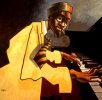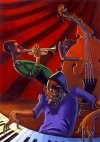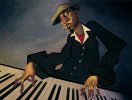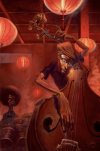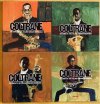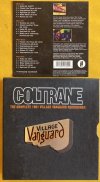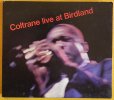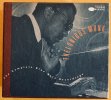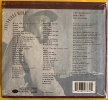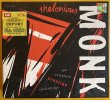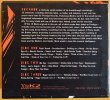True Bromance
Philip Clark
Indian Sun: The Life and Music of Ravi Shankar by Oliver Craske. Faber, 672 pp., £12.99, June
Oliver Craske begins his biography of Ravi Shankar by telling an Indian parable. A blind man, stroking an elephant’s trunk, thinks he is holding a snake. Another blind man, running his hands along the animal’s leg, assumes he is touching a tree trunk; a third mistakes its tail for a rope. People’s response to Indian classical music is the same, Shankar told a press conference in London in 1966. Americans hear resemblances to jazz and Japanese musicians hear echoes of their own folk traditions. ‘But the similarities are very superficial,’ Shankar said. ‘Beyond that, there is something very deep that is yet to be appreciated by Westerners.’
Images of Shankar – sitting cross-legged on a carpet, playing his sitar – have become synonymous with Indian classical music, yet when his story is told it too often focuses on his starry associations. Through his friendship with George Harrison, Shankar inadvertently altered the course of popular music, spinning the Beatles in a new direction. Meeting Shankar changed things for John Coltrane, too, helping him shake his dependence on drugs, while opening his ears to Eastern scales. Before Philip Glass worked with Shankar on a film score in 1965, he had been churning out unremarkable pastiches of French neoclassicism fused with folksy Americana; discovering the rhythmic loops of Indian music kickstarted his first pieces of minimalism. A generation earlier, Benjamin Britten had been entranced by Shankar’s first British performances. Yehudi Menuhin’s reputation as a child prodigy was built on the recording he made of Elgar’s Violin Concerto in 1932, but he too was steered onto a different path by Shankar.
It’s intriguing that a single musician could exercise such an influence, but that isn’t the story Craske wants to tell. Shankar, he claims, was unnerved by the growth in crossover culture – projects casually labelled ‘East meets West’, Indian music with a backbeat, and the emergence in the 1960s of ‘raga rock’. It was fine for the practices of Indian classical music to meet Western forms, he felt, but traditional music – the essence of that ‘something very deep’ – should never be subsumed within Western musical structures. He had cultural reservations too. He played at the Monterey International Pop Festival in 1967, but he wasn’t in sympathy with the summer of love. His music was mind-expanding enough, he thought; there was no need to be stoned to appreciate it. Instruments were sacred objects and he was distressed by the onstage trashing of guitars. Ten years earlier he had played at the International Summer School of Modern Music at Darmstadt and the music he heard there – by Pierre Boulez, Edgard Varèse and the English twelve-tone composer Humphrey Searle, among others – made him feel sick. And while he recognised Coltrane’s improvisational genius, to Shankar’s ears the turbulence of the music opened a voyeuristic window into a troubled mind. The Indian classical tradition, by contrast, emphasised serenity and inner peace.
‘He wanted to be in the purest sense a presenter and promoter of the classical tradition,’ Shankar’s daughter Anoushka, herself a sitar virtuoso, told Craske. ‘But he also rebelled against the restraint that implied, and fought to be creatively free and experimental.’ The tug of war between tradition and innovation is central to Craske’s study. He first met Shankar in 1994, when he was sent to help him write an autobiography, Raga Mala, which appeared three years later. Shankar made clear that some of the material – especially about his tangled personal life – was to be aired only after ‘I’m gone’. It’s included in Indian Sun, published last year to mark his centenary.
Robindra ‘Ravi’ Shankar was born in 1920 in the northern Indian city of Benares. His mother, Hemangini, was eleven when she was married to Shankar’s father, Shyam, who had aspirations to practise law. Shyam had only a limited tolerance for family life and spent long stretches of time living apart from Hemangini and their five children. He also took a second wife, an English woman ‘whose family had cut her off’, Craske writes, ‘for being the mistress of a “black devil”’. It wasn’t against the law at the time for a Hindu man to have two wives, but ‘it was rare and generally disapproved of.’
Shyam was appointed foreign minister in the state of Jhalawar and left for Europe the year Ravi was born, appointing a family friend as his children’s guardian. With his father absent, his oldest brother, Uday, a dancer, touring Europe, and his favourite brother, Bhupendra, occupied, Ravi lacked male role models; tutored at home, he had no friends either. It was at this time that he was sexually abused over a number of years by a man he described as an ‘uncle’ when in his seventies he first talked about what had happened. He was close to his mother, who sang to him – semi-classical pieces and folk songs – and told him stories from her childhood. They were short of money and Ravi felt her humiliation at having to take menial jobs, like making blouses on her sewing machine, and pawning jewellery.
Ravi was eight when his father returned. ‘Wearing his best Savile Row suit and with his fair complexion,’ Craske writes, ‘he looked like a British sahib’ to the ‘awestruck Robu’. Shyam had arrived with two female companions: his current girlfriend and the cousin of his English wife, who had died a couple of years earlier. Over a breakfast of fried eggs at a fancy hotel, Ravi, who was used to eating with his fingers, was ‘bombarded with instructions on how to use the cutlery’; he later recalled the humiliation when the yolk dribbled onto his clothes. After staging shows for Indian soldiers in Britain during the First World War, Shyam had had a one-act ballet, The Great Moghul’s Chamber of Dreams, staged at Covent Garden in 1924. The billing said it was ‘based on native melodies collected by Pandit Shyam Shankar, and orchestrated by Western musicians’. From this we can assume that Shyam had no formal musical training, but could recognise a good tune.
Shankar’s own musical training was unconventional at first. In Indian culture, musical knowledge is usually passed down within families, starting when the child is very young. Instead, Ravi drifted towards music. In February 1930 Uday returned to India for the first time in ten years. He had trained as a painter – including a spell at the Royal College of Art. He had danced for King George V, and Anna Pavlova had invited him to choreograph a set of Indian dances, which were performed at Covent Garden the year before his father’s ballet was put on there. ‘He is endowed with one of the most perfect bodies I have ever seen in a man in any country,’ Pavlova said, encouraging him to follow Indian dance rather than ballet, and to present it afresh, as Tagore had Bengali poetry.
After London Uday had gone to Paris, where he developed a sequence of authentic dances. Having attracted a wealthy backer, his plan was to set off on a grand tour of India, collecting instruments and costumes along the way, and recruiting a troupe of musicians and dancers he could take back to Europe. But the funding didn’t materialise and Uday ended up drawing on the talents of his family instead. Brothers, in-laws and uncles were co-opted into the troupe, and Hemangini was persuaded to come along to maintain family order – which also meant bringing ten-year-old Ravi, who fell immediately into a travel habit he would maintain for the rest of his life. The sights, the fashions, the smells, the food, the hot and cold water taps: Ravi was dazzled by Paris and intoxicated by the affection shown towards his family. Their first show, at the Théâtre des Champs-Élysées, sold out and had adulatory reviews. The Shankars met Cole Porter, Gertrude Stein and Henry Miller, and over the next few years travelled all over Europe and eventually to the US, where Ravi heard Duke Ellington, Count Basie, Cab Calloway and Louis Armstrong, beginning a lifelong fascination with New York.
Ravi began taking small dance parts in the troupe’s productions, but his attention was increasingly drawn to the sitar. Back in Calcutta, now fourteen years old, he practised obsessively. The guru of gurus at the time was the sitarist Enayat Khan and Ravi was set to become his disciple, but a day before the formal ceremony to bind disciple and guru, Shankar developed typhoid: it was an ‘ill-starred’ relationship, Craske insists. A year later, in December 1934, Shankar saw the man who eventually became his guru, Allauddin Khan, perform at the All-Bengal Music Conference (Tagore and the 13-year-old Satyajit Ray were also in the audience). On the first day, Khan led an orchestra of local orphans playing a mixture of Indian and Western instruments; on the second, he gave a recital on a string instrument called a sarod. The following year, Khan joined Uday’s troupe on a tour through the Middle East and on to Europe. Hemangini pleaded with him to look after Ravi ‘as your son’. A few months earlier, Shyam had died in circumstances that were never fully explained. He had been representing one of two warring Bengali brothers in a legal case in London, and had been assaulted outside his hotel, sustaining fatal head injuries. Within a year of Ravi’s departure from Bombay, his mother too was dead.
Ravi was away from India for two years. Tours of Europe were interleaved with stays in London and Paris. There was a five-month residency at Dartington Hall, and journeys across the Atlantic for performances in the US. A recording of a concert in New York was the first album of Indian classical music to be released in the West. After a final show at Carnegie Hall in March 1938, they returned to Europe but, Craske writes, ‘prospects there were too bleak,’ and most of the performers, including Shankar, returned to India.
During two months spent coming to terms with his mother’s death in her home village, Ravi finally underwent the rite of passage into Brahmin adulthood, which usually happens before the age of twelve: he was now eighteen. He shaved off his hair, learned the mantras, and lived like a monk for a few weeks. Then he travelled to Maihar, where Allauddin Khan was the court musician at the royal palace, to begin a new life, austere and regimented, waking at 4 a.m. every morning. From now on the study of music would be his sole focus. The starting point was a proper appreciation of the Indian vocal tradition, of which instrumental playing was an extension. He would also have to unpick the idiosyncracies of his largely self-taught technique. For Khan (known as ‘Baba’, an honorific melding ‘guru’ and ‘father’), music was next to godliness, and he could lash out when students frustrated him; one boy was hospitalised after being struck with a tuning hammer. He prayed five times a day, abstained from alcohol and ‘adhered to the old belief that indulging in sex reduced a musician’s powers’. Shankar spent the next seven years with him in devotional study.
Baba’s philosophy of music was rooted in the idea of gharana – the passing of an artistic tradition from one generation to the next, through example and explanation. As the months and years passed Shankar came to understand the way the distinct sections of a raga could flow and contrast within a performance: the way a freer opening part, called alap, established a matrix of melodic possibilities which was given a rhythmic backbone, the tala, as the piece moved into its next section, the jor. Each tala has its own mathematically complex beats, chains of twos and threes with occasional half-beats dropped in to make the syncopation bite.
Many years later, on an album called The Sounds of India, Shankar talked through the structure of an improvisation as he performed it. ‘Ragas are precise melody forms,’ he explained. ‘A raga is not a mere scale, nor is it a mode.’ He explained the importance of microtones – the notes between the rigidly tuned notes of Western scales, usually ignored by Western composers – and described the melodic contours that twist up and down the raga. As the tanpura, a bulkier and more resonant cousin of the sitar, sustained a drone, improvisations shifted from smaller, scene-setting patterns into extended melodic lines. With his American audience in mind, Shankar warned listeners not to confuse his music with jazz.
Anyone learning to play music rooted in improvisation seeks to digest the rules to the point where they become instinctive, which makes it possible then to unlock the imagination. Each raga was an expression of one of the nine basic emotional states, or rasas, originally set out in a Sanskrit text two thousand years ago. A raga was a melody form, as distinct from a fully realised melody: it laid out a system of instructions for the development of melodic structures. The rules stated which notes needed to be emphasised; the stress on certain notes locked others out of the design, thus creating the melodic shapes that gave each raga its personality. In performance, Shankar would engage in a dialogue between the rules and the moment, listening intently to the development of his own patterns and to the way his fellow musicians were responding, to drive the music forwards.
‘In the beginning it was more perspiration than inspiration,’ Shankar remembered. After many months, Baba allowed him to train alongside other disciples: in the first instance his son Ali Akbar and his daughter Annapurna, who excelled at the surbahar (the bass sitar). Ravi and Annapurna married in 1941; their son Shubhendra was born in 1942. Shankar started to play in public and, in 1942, gave his first radio recital in Bombay. His relationship with Annapurna began its long unravelling as she worried, not without justification, that Ravi was unfaithful when he was away from her. His relationship with Uday suffered too: Ravi’s decision to pursue music over dance upset his brother, and Uday was jealous of his success. He cut Ravi’s monthly allowance, plunging the new parents into a financial crisis. Relief came when a rich industrialist agreed to become Shankar’s patron. He spent five hundred rupees on a new sitar, designed to his own specifications, and told Khan that he was ready to leave Maihar.
Shankar was disturbed by the rioting and sectarian violence that accompanied Partition. When Mahatma Gandhi was assassinated in 1948 he improvised an alap on All India Radio, with his sitar tuned to the syllable sounds of Gandhi’s name. By now his financial problems were overwhelming. The income he was getting from recitals and film scores never quite paid the bills, and he was being sued as the result of a failed theatrical production. He made a plan to kill himself after playing one last recital. But as he practised on the morning of the recital, there was a knock on the door. Tat Baba, a ‘saintly yogi’, asked if he could use Shankar’s bathroom. Seeing the state Shankar was in, he persuaded him to cancel his performance. Instead, Shankar played while Tat Baba meditated. ‘The money you missed tonight will come back to you many times over,’ Tat Baba told his new disciple. ‘Don’t do anything foolish.’
Tat Baba’s prophecy was soon fulfilled. In 1949 Shankar was made director of music at All India Radio. Jawaharlal Nehru, India’s first prime minister, believed that support for the arts would help unite the country, and made extra funding available. Shankar was handsomely paid. He planned music for broadcast, including sitar concerts of his own. AIR had modelled itself loosely on the BBC, with its resident orchestras, but it was Shankar’s task to figure out how massed instrumental music could work in India, where classical musicians tended to consider themselves soloists, and given the difficulty of orchestrating improvised ragas using music notation. Performances of ragas were focused on the development of a single melody line created by a single player: what was one supposed to do with all those extra instruments?
Shankar’s initial solution was to rehearse his musicians enough that they could play scored music with such abandon it sounded improvised. To avoid the timbral monotony of having the entire ensemble play in unison, he threaded melodic lines between different groups of players, revealing constantly changing instrumental colours. Eyebrows were raised when, later, he added Western string instruments and clarinets to the ensemble, but these judiciously selected instruments extended the orchestra’s range and deepened its sound.
Shankar was already thinking about the outside world, and the ways he might perform his music overseas. It was Menuhin who eventually persuaded him to take the plunge. Shankar and his tabla player, Chatur Lal, played privately for Menuhin when he visited India in 1952. ‘That was music-making I could have only dreamed of,’ Menuhin said. Craske speculates that he heard a freedom in Indian music denied him by his own ‘corseted’ upbringing. Three years later, Menuhin invited Shankar to the New York premiere of Satyajit Ray’s Pather Panchali, for which Shankar had provided the music. The plan was that he would play a concert at the Museum of Modern Art and appear on Alistair Cooke’s TV show, Omnibus. But Annapurna, suspicious of affairs, refused to let him travel to New York alone. She accused him of sidelining her musical career in favour of his own, and began an affair with one of his pupils.
He finally made it to the US in November 1956, having resigned his radio job and gambled everything on the success of the trip. He travelled via London, where he played recitals, recorded for the BBC and made his first album – Music of India: Three Classical Ragas – at Abbey Road Studios. He had given careful consideration to the way he should perform Indian classical music in the West, realising that American and European audiences would struggle to cope with the five or six-hour performances he was used to. He recognised that an audience reared on Gene Krupa or Buddy Rich would have less difficulty accepting drum sounds than the rarefied timbre and tunings of the sitar, so he gave greater prominence to Chatur Lal.
In New York, Shankar was fêted by jazz musicians, and photographed with Dizzy Gillespie, Count Basie, Quincy Jones and Shelley Manne, but there is no report of his meeting equivalent figures in classical music. George Avakian, the head of popular music at Columbia Records who had signed Dave Brubeck and Miles Davis, heard Shankar play at New York Town Hall and invited him to record for the label, which resulted in The Sounds of India. Also present was Richard Bock, head of Pacific Jazz in Los Angeles, who recorded Shankar when he visited the West Coast a few weeks later. Shankar’s very healthy sales shifted the label, which had been devoted to jazz, towards a new identity as World Pacific Records, in which jazz took its place alongside what would be called world music. Avakian was keen for Shankar to tour with Brubeck, a plan that foundered on Shankar’s reluctance to involve himself too deeply with contemporary jazz. The jazz that spoke to him – Armstrong, Basie, Ellington – had, he said, ‘innocence, life and soul in it. Their music was not as intellectual as the atonal, modern and avant-garde varieties you hear today.’ Shankar was treading a fine line. He yearned for his music to be appreciated in the West but, like it or not, the audience for the increasingly complex improvisations of John Coltrane, Charles Mingus and Ornette Coleman was his audience too.
Shankar’s popularity was such that he was able to fill the Royal Festival Hall in 1958. The next time he played there was in October 1963. That same evening, across the Thames at the London Palladium, the Beatles were playing in front of a live television audience. At this point, George Harrison hadn’t discovered Indian music. He first picked up a sitar on the set of Help! in 1965 – there was a scene set in an Indian restaurant – and later that year heard about Shankar, buying his records and a ‘crummy’ sitar of his own, which he took with him to Abbey Road when the Beatles recorded ‘Norwegian Wood’. His shadowing of the lead melody line on sitar was technically amateurish, but the sound of the sitar implanted into the standard rock group line-up of electric guitars, bass and drums helped push Shankar into mass consciousness. Harrison and Shankar finally met in 1966. It was a true bromance. Unlike most of the people in Harrison’s life, Shankar never fawned. He was deeply unimpressed by ‘Norwegian Wood’ and the other attempts the Beatles had made to flavour their songs with Indian sounds. But he saw a quality in Harrison that he liked and offered to teach him the sitar – properly.
In 1965 Shankar had been persuaded to provide music for The Psychedelic Experience, a short film introduced by Timothy Leary which followed a man on a mescaline trip. Later Shankar felt deeply embarrassed by his involvement, and claimed he hadn’t realised that the film would be used to promote drug use. He was sympathetic to the general spirit of revolt of the time – he was against the Vietnam War, in favour of Civil Rights protests and ‘needed no teaching about free love’ – but the spectacle of musicians getting stoned and playing music that, to him, perpetuated ugliness and violence was a puzzle.
At the Monterey International Pop Festival in June 1967, the high watermark of his popularity, Shankar asked the audience not to smoke, then performed a three-hour set blending meditative sitar soliloquies with the rhythmic exhilaration of extended tabla solos. Shankar enjoyed listening to the Mamas and the Papas, Simon and Garfunkel, Otis Redding and Janis Joplin, who he said reminded him of an old-school jazz singer like Bessie Smith, but was saddened by Hendrix and The Who, with their sacrilegious destruction of instruments. ‘I am immediately repulsed by anything ugly that sends out bad vibrations,’ he wrote in 1968.
In the context of 1960s hippie culture, ‘vibrations’ – good or bad – was a loaded word, but it’s possible that Shankar was referring to the physics of sound. Playing Indian classical music when stoned isn’t a good idea: a clear head is needed to negotiate the tiny variations of tuning integral to a raga. The seven years Shankar had spent studying with Baba had made the sitar like an extension of his body: he knew when vibrations were flowing naturally and unimpeded, and when they were not.
In 1965 Menuhin asked Shankar to collaborate in an ‘East meets West’ composition that would allow for ‘rhythmic and melodic freedoms within a set pattern’. Menuhin had approached Benjamin Britten, but he rejected the idea as unworkable. Eventually Peter Feuchtwanger was chosen – he had an interest in Indian and Arabic music – but the project was doomed from the start. Menuhin had promised Shankar that the score would be a ‘useful point de départ’, but it ended up swamping the musicians with superfluous notation. Shankar would only bend so far to the composer’s will. The final performance had a brief nod to Feuchtwanger’s composition as an opening flourish – then Shankar cut free.
Out of this, however, the celebrated Menuhin/Shankar musical partnership was born, producing two smash-hit volumes of West Meets East. Menuhin’s devotion to Shankar, and his super-sensitive ears, were enough to pull him through these recordings, but Craske is right to identify awkward moments – the occasional rhythmic stiffness or decorative figuration more suited to Mozart – that jut out like the occasionally unwieldy sentences of someone speaking in a second language, no matter how fluent they are.
In 1971, Shankar recorded his Concerto for Sitar and Orchestra with André Previn’s London Symphony Orchestra. Previn later described the piece to me in an interview as ‘absolute, total, utter shit’. He was frustrated, he said, to arrive at the studio and discover that Shankar ‘hadn’t orchestrated it’. But Craske’s account of the same occasion persuades me that Shankar hadprepared the material as he understood it. Experiences like this and the earlier one with Feuchtwanger touched a raw nerve, Craske thinks. Shankar understood and respected the Western system of notation, but this was not the way Indian classical music worked. Craske suggests that Feuchtwanger’s score breached ‘the raga’s integrity’, but Shankar’s objections might have been deeper than that. Western tuning, compared to the rich micro-tunings of the Indian classical tradition, offers a narrower bandwidth of possible notes, and stave notation is notoriously imprecise when it comes to tunings more complex than the Western norm. Shankar’s album Inside the Kremlin(1988), on which his musicians work with Moscow-based orchestral players, sounds sugar-coated and synthetic, the generic orchestral sounds doing the music no favours. It was the sustained drone of the tanpura that licensed Shankar’s improvisational imagination, and which underpinned the development of Indian classical music as a continuum, in contrast with the episodic narratives characteristic of Western music.
Shankar was given a seat in the upper chamber of the Indian Parliament, the Rajya Sabha, in 1986. But on the day he was due to deliver his maiden speech, he was having bypass surgery in California. By this time, much of his musical and personal life had become rooted in America. He loved New York, but the Californian climate suited him better, and he taught at UCLA and the California Institute of the Arts. He was married, happily, for a second time in 1989, to Sukanya Rajan, Anoushka’s mother, and they lived in Encinitas, north of San Diego. He died in December 2012, just a few weeks after his final concert, with Anoushka, in Long Beach, where oxygen tanks were on hand to aid his breathing. Clips show an alarmingly fragile Shankar playing a sitar modified to compensate for his frailties. But he sounds utterly alive to the moment, fortified by the love of his audience, carried away on a wave of good vibrations.


